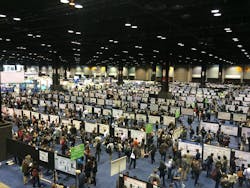Increasingly, neuroscientists are working with researchers in disciplines such as chemistry and physics. This trend has been noticed by exhibitors at the Society for Neuroscience (SfN) annual meeting (October 17-21, 2015; Chicago, IL), and was in evidence throughout the conference program (see figure). Perhaps such collaboration is why the field of neuroscience seems better able to appreciate the capabilities of technology. For sure, exhibitors at Neuroscience dished up plenty to entice them.
Many developers have innovated to ease the use of sophisticated tech. For instance, durable-equipment developer Sutter Instrument has paired with high-performance filter developer Semrock to offer filter changers specially designed for wavelength selection over a wide spectral range to any given nanometer value. Now, with the release of Semrock's VersaChrome Edge filter technology, which allows selection of bandwidth as well as center wavelength (and blocking outside the passband with an additional filter), Sutter has released the VF-1 Edge system to ease selection of both the long and short ends of the bandpass via the instrument or device such as a computer. Also new from Sutter is its first major new product line in two decades: a suite of electrophysiology recording hardware and software (Integrated Patch Amplifier) to enable efficient, low-noise, whole-cell recordings.
Smile for the camera innovations
Speaking of low noise, Photometrics demonstrated how onboard software in its Prime sCMOS camera can improve outcomes: Its PrimeEnhance feature promises to reduce active shot noise by 300–500%, while PrimeLocate automatically detects and transfers regions of interest, and easy cropping reduces file sizes.
And Hamamatsu upped the imaging ante with its ORCA-Flash 4.0 V2 sCMOS, promising not only improved read noise, but also quantum efficiency (QE) up to 82% to detect very faint signal and reduce exposure times. Other enhancements include enhanced frame rate (100 frames/s max at full resolution) and dynamic range. To help you gauge the actual QE that you will achieve (the 82% is at about 600 nm wavelength), the company gave away slide rules that show the camera's photon output using grey levels or analog-to-digital units (the measure that your imaging software uses to report intensity) in any region of an image.
Advanced spatial light modulators
While the average neuroscientist may not have known that spatial light modulator (SLMs) can have dramatic impact on his/her experiments, a few exhibitors demonstrated just that. Boulder Nonlinear Systems (BNS) showed how next-generation SLMs are helping to drive scientific advances. The company displayed PocketScope, a portable single-photon SLM microscope able to image or photostimulate different regions of a sample simultaneously, with 3D precision and at high frame rates. BNS is preparing the instrument, developed in the lab of Columbia University neuroscience pioneer Rafael Yuste, for commercial release. Future SLM development promises more exciting applications.
Meadowlark Optics, a development partner of BNS, also showed how high-speed SLMs increase the number of 3D neuronal ensembles able to be excited simultaneously. And Phi-Optics promoted Spatial Light Interference Microsopy (SLIM) as an add-on to all major brands of optical microscopes for quantitative cell imaging.
ASI drew attention with an impressive display of its dual inverted selective plane illumination microscopy (diSPIM), which offers light-sheet excitation and emission from both the right and left. And Mad City Labs showed off its Kohler Illumination Tower, providing an extra-long working distance (>30 mm!) for use with live-cell chambers. Prior Scientific displayed a precision-control setup that included a super compact 3-axis manipulator from Sensapex.
Optogenetics
Among the many companies exhibiting optogenetics offering was Mightex, which showed its Optical Activation, Stimulation and Imaging System (OASIS) for in vivo and in vitro research, and its new optogenetics starter kits—turnkey solutions for ChR2 stimulation offering super-high output power (up to 7.2 mW with a 200 μm fiber) and ultra-low power variation (<2%) during rotation.
Coherent discussed optogenetics research based on multiphoton excitation principles for in vivo work: Its Chameleon and Fidelity products support standard imaging with fluorescent proteins, optogenetic activation, and monitoring of neuron activity using genetically encoded Ca+ indicators.
For Part 2 of our Neuroscience coverage, please visit http://bit.ly/3qURHWy.
About the Author

Barbara Gefvert
Editor-in-Chief, BioOptics World (2008-2020)
Barbara G. Gefvert has been a science and technology editor and writer since 1987, and served as editor in chief on multiple publications, including Sensors magazine for nearly a decade.
